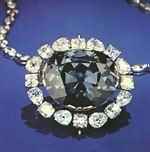


The famous blue Hope Diamond, weighing 44.52 carats, is reputed to be unlucky for its owner. It is named after a former owner, Henry Philip Hope. The Hope Diamond is on permanent display in the Smithsonian Institution.
This great blue diamond is perhaps the most notorious gem in history. It has left behind it a trail of so many unlucky owners that it has been popularly supposed to be cursed. The Hope was mined in India, and the 112-carat gem was brought to France in 1668. It was said that a curse rested on it, for a thief was reputed to have stolen the diamond from the eye of a statue of the Hindu goddess Sita, wife of Rama.
Tavernier, who brought the gem from India to France, sold it to Louis XIV, who had it cut into a 67-carat heart-shaped stone and named it the Blue Diamond of the Crown. Tavernier is said to have been killed by wild dogs on his next trip to India.
Louis XVI and Marie Antoinette inherited the French Blue, as it was popularly known. In 1792, about the time of their executions, the French Blue was stolen from the Garde-Meuble together with all of the French crown jewels. Some of the gems taken in this robbery were recovered, but not the Blue Diamond of the Crown.
It is intriguing to note that a gem resembling the Hope is worn by Queen Maria Louisa of Spain in a portrait painted by Goya in 1800. There are reports that the stolen French Blue was recut to its present size by Wilhelm Fals, a Dutch diamond cutter. Fals is said to have died of grief after his son, Hendrick stole the gem from him. Hendrick, in turn, committed suicide.
In 1830, there appeared in London a 44.5-carat deep blue oval-cut diamond the gem experts agree was the French Blue recut to conceal its identity. Henry Hope bought i, and since then it has been known as the Hope diamond.
The Hope moved on. An Eastern European prince gave it to an actress of the Folies Bergere and later shot her. A Greek owner and his family plunged to their death over a precipice in an automobile accident. The Turkish sultan Abdul-Hamid II had owned the gem only a few months when an army revolt toppled him from his throne in 1909.
Evalyn Walsh McLean, a wealthy and eccentric American social figure, bought the Hope diamond in 1911. Her son was killed in an automobile accident, her husband died in a mental hospital, and her daughter died in 1946 of an overdose of sleeping pills.
After Mrs. McLean�s death in 1947, New York jeweler Harry Winston purchased her jewels, including the Hope. He gave the gem to the Smithsonian Institution in Washington, D.C., in 1958, no doubt with a certain sense of relief.
Coincidence or not, the diamond seems to have brought enormous troubles in its train.
Source: The Great Book of Jewels, Ernst A. and Jean Heiniger, 1974, Printed in Italy
